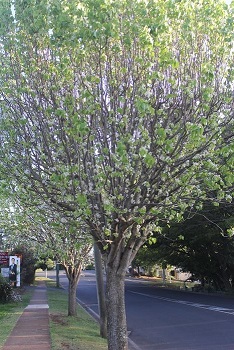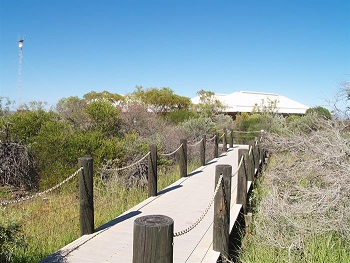
Are you working in your own business, perhaps gardening or similar, and you want to broaden the practical skills you have into landscaping? Are you starting out in a new career and love working outdoors? Do you have design ideas that you want to put into practice and enjoy working with others?
Being a landscaper is gratifying - build beauty with nature!
GET STARTED WITH THREE CORE MODULES
Landscaping I
- Basic Design Procedure
- History of Gardening
- Draughting and Contracting
- Basic Landscape Construction
- Surfacings
- Furnishing and Features
- Park Design - Part 1
- Home Garden Design
- Design Procedures
- Park Design - Part 2
 Landscaping II
Landscaping II
- The Garden Environment
- Landscape Materials
- Using Bulbs and Annuals
- Landscaping with Trees
- Ground Cover Plants
- Walls and Fences
- Paths and Paving
- Treatment of Slopes and Other Problem Areas
- Garden Features
- Designing for Low Maintenance
- Development of a Landscape Plan
- Management of Landscape Projects
Landscape Styles
- Creating the Mood
- Historic Gardens
- Formal Gardens
- Oriental Gardens
- Middle Eastern and Spanish Style
- Mediterranean Gardens
- Coastal Gardens
- Modern Gardens
- Eclectic Gardens
- Other styles
CHOOSE THREE ELECTIVES FROM THIS LIST AND MAKE YOUR CERTIFICATE UNIQUE TO YOU!
Landscape Construction
Carpentry
Green Walls and Roofs
Landscaping home gardens
Practical Horticulture I
Practical Horticulture II
Machinery and Equipment
Engineering II - Applications
Biophilic Landscaping
Trees for Rehabilitation
Soil Microbiome Management
Soil & Water Chemistry
Design then Construction
Urban landscaping has two aspects to it: first designing the landscape, then constructing it.
A good designer needs to understand construction in order to design properly; and a good landscape builder must understand the design in order to build it as intended. Sometimes the designer and builder are the same person; but more often than not, they are different people.
Constructing a landscape involves using a wide variety of different materials: plants, soil, rock and stone, timber and concrete, and a lot more.
Building with Wood
 There are many different materials which are called upon in carpentry and it is important to gain an understanding of these along with tools.
There are many different materials which are called upon in carpentry and it is important to gain an understanding of these along with tools.
1) Sandpaper
This is an abrasive paper used for finishing work as well as to reduce thicknesses, straighten surfaces, and remove rough edges. Sandpaper used to be made by sticking particles of sand onto paper, but these days it is more usually made using particles of glass (hence the name glass paper), silicon carbide, aluminium oxide, or something similar and all of which may be regarded as 'grit'.
Grit is sieved into grades determined by the number holes per linear inch where the greater number of holes only allows the passage of finer particles through. In the following table, 240-grade sandpaper is classed as very fine:
Grade Particle (grit) and Size
Very fine 240 +
Fine 180-220
Medium 120-150
Medium Coarse 80-100
Coarse 40-60
Thicker paper is used to back sandpapers used on belt sanders and orbital ones. Finer paper is sufficient for hand sanding. Other backings include waterproof paper for use with liquids, and cotton cloth for jobs which need the paper to be more flexible.
Sandpaper is available in several different forms:
- Sheets - for hand sanding. These may be wrapped around a wooden block for ease of use.
- Rolls - for electric sanders (but cut be used for hand sanding). May be cut to size.
- Belts - made in specific sizes to accommodate different models of belt sander.
- Discs - solid disks may be used in electric drills or rotary sanders. Discs are quite stiff with a flexible backing.
Sandpaper is always best applied along the grain of wood, or in a circular pattern on surfaces without grain. It should not be pressed too firmly because it will quickly become clogged and worn. Sandpaper for hand sanding should not be used on power tools as it will quickly deteriorate and you could damage the timber. It is preferable to start with a coarser grade of paper and finish off with a finer grade.
2) Steel Wool
Like sandpaper, this is used for smoothing wooden surfaces especially in cabinet making. Steel wool provides a smoother surface than even the finest sandpaper. Its action very finely cuts the surface rather than abrading it.
Like sandpaper it is graded according to its coarseness with 5 being very coarse and 0000 being exceedingly fine.
3) Nails
There are a wide variety of nails used for fixing. They often have different shaped heads and shafts depending what they are to be used for. They also vary in length and gauge. Some of the more common ones used in carpentry are as follows:
- Floorboard nail - these are flat and tapered down one side giving a triangular profile with a flattened head and pointy tip.
- Round wire nail - these are long nails with a round shaft for general purpose jobs where appearance is not important. They have a broad round flat head. They may split timbers if used carelessly.
- Oval wire nail - these are also long nails for general purpose jobs but they have an oval shaft and so do not split timbers as readily if the narrower section is hammered into the timber with the grain.
- Lost head nail - these are used where the head of the nail needs to be hidden since the head of the nail is very small. This can be achieved by finishing off with a nail punch.
- Twisted shank nail – for attaching decking, joist hangers, and soft timbers. The twisted shank adds more grip enabling the nail to hold down decking boards which are subject to heavy foot traffic.
- Galvanised clout – for attaching soft timber such as lattice, as well as plasterboard. They have a broad round flattened head.
- Tack - these are used for affixing fabric to timber e.g. furniture upholstery. They usually have beveled edges on the shaft which tapers to a point.
- Panel pin (brad head nail or brad) - these are small thin nails with a rounded head used for delicate joinery.
- Sprig - a wedge-shaped nail used chiefly for holding glass in window frames.
- Hardboard pin - these are a similarly shaped nail to a panel pin except the head is diamond-shaped so that it sinks into hardboard when used.
- Annular nail - these are nails with a ribbed or threaded shaft for extra grip. They may be used with plywood or decking.
4) Wood Screws
These are distinguished by the type of drive and the shape of the head. The drives may be:
- Slotted - these have a single slot in a straight line across the top of the screw into which the screwdriver is inserted.
- Phillips - these have a cross-shaped slot on top.
- Pozidrive - these have a modified cross-shaped slot on top.
- The head shape may be: lat-head - these may also be known as countersunk screws since the head is designed to be countersunk into the surface of the timber.
- Rounded - these have a rounded head above the surface of the timber when screwed tight.
- Raised - these are countersunk but have a slightly raised head when screwed tight.
Screws may also be differentiated by the length and gauge (thickness) as well as the material used. Galvanised steel screws are widely used but brass may be preferred for aesthetic purposes or where there is a possibility of screws being affected by rust.
5) Glues
Traditional wood glues are made from animal skins. These glues are still used for some specialist purposes such as in restoring antique furniture and in making musical instruments, but for many woodwork purposes they have been replaced with other types of adhesive. Glues are often used when joining two pieces of timber together especially in association with finer grades of brad nail or inside specialist joints to add further strength. They are also applied when using dowels.
Some of the more common wood glues in use are:
- PVA (polyvinyl acetate) - this provides very strong bonds between two pieces of timber (arguably stronger than the wood itself), but is not good for bonding wood to other materials. The wood needs to be clamped together during the drying process. These glues are best used in joints where screws, nails, and other fixings are applied since the plastic nature of the glue will eventually cause the joint to break apart without reinforcement. They also don't bind with other glues and so should not be used in antique furniture repair if older glues cannot be adequately removed.
- Polyurethane glue - these glues provide a very strong bond because the glue expands after reacting with moisture in the air or the timber and fills all the space in the joint. The glue is waterproof and can be sanded down and stained which makes them very useful. They take longer to set than other glues and so timber must be clamped. Any excess glue should be wiped off immediately with a solvent.
Other glues may be used in the manufacture of composite boards such as resins. Urea formaldehyde is one such resin which comes as a powder and is mixed with water. It is water resistant and is not affected by fungi and moulds making it useful for outdoor projects. However, it can break down quickly in hot, moist places and will release the toxic formaldehyde when it does.
Epoxy is mostly applied in two parts (resin plus hardener) and can be used under a wider range of moisture content and temperatures than other types of glue.
6) Wood Filler
An easy method for filling holes created in woodwork projects is to mix some sawdust from the timber used with a dollop of glue and place it in the hole. Other fillers are usually made from epoxy or putty.
- Epoxy - this does not expand or contract with temperature changes this makes it excellent for filling larger holes. It is usually in the form of an adhesive and a resin which are mixed together into a paste and then applied to the hole. It dries extremely strong making it hard to undo mistakes.
- Putty - these fillers are sold in various shades to closely match typical timber colours. For unusual colours, two or more fillers may be mixed to create a close match. These are best suited to smaller holes since they are not as strong as epoxy.
WHAT DO YOU NEED TO WORK AS AN URBAN LANDSCAPE DESIGNER?
A landscape designer will know the fundamental skills behind landscaping because landscape design is multi-faceted, it not only about the garden design i.e. making a lovely garden. It is about suiting the landscape to the climate, soils, topography and the setting that you have to work with. An understanding of plants, soils, timbers, climate, and other landscape materials plus landscape construction methods are pivotal to the success of a good landscape design.
Will I find work as an Urban Landscape Designer?
There are many things that help find people work – many people in landscaping work for themselves. Some start out as gardeners and realise that have skills in design as well and go on to pursue that. Others work for landscaping companies as their resident designer or for builders designing gardens for their display homes.
Many people are outsourcing their landscaping these days - there is far more interest in designed urban spaces than there has been in the past. There are many opportunities out there but you need the skills to benefit from them:
Doing a course is great but it is what you learn from that course that really matters. A course such as this is hands-on yet also covering all the fundamentals of design, landscape construction and plant selection will certainly help but it isn’t the only thing:
- Confidence in your work is one thing - if you know your subject you are better able to exude confidence to your clients or potential employers.
- Passion for your work is another –people that are passionate about their work tend to learn more and are able to recall it better. They are much more likely to undertake a course of study and to learn a lot from it.
- A professional approach - always maintain a professional approach to your work, your clients, when you attend job interviews and in the workplace in general. Professional people understand boundaries in the workplace – they won’t make inappropriate comments or be flippant to their employers, workmates or customers. A professional approach also uses good communication skills both verbal and written and will include confident use of technology.
- Be efficient – efficient doesn’t mean ‘fast’ efficient means finding the most appropriate ways of doing this in the right order. This automatically makes a task faster to do as well. Efficiency can be learned - for example at ACS we focus our courses on developing problem solving skills along with fundamental knowledge needed to work in the industry. Doing problem solving tasks in your course helps you retain the things you have studied – you can store the knowledge and are far better at recalling this knowledge later (even years later). If you just learn to do things by rote, you are less likely to truly understand the subject you are studying.
- Network with others – networking is the single most efficient way of making you known as an urban designer. Join industry associations, set up a facebook page, do blogs, join linked-in, attend industry seminars, garden shows and exhibitions, introduce yourself to others in the industry. Make yourself known!